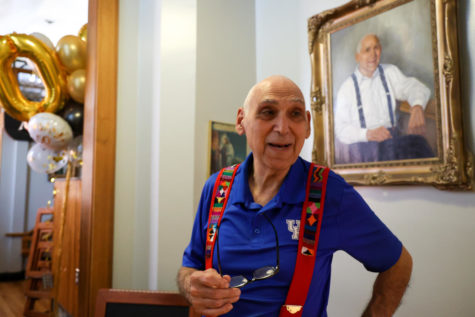Students see red to support heart health month
February 5, 2010
A sea of a color other than blue will be taking over the state Friday to raise awareness for the top killer in the U.S.: heart disease.
February is American Heart Month, created to raise awareness of heart health issues. Friday kicks off the month’s events with the American Heart Association’s National Wear Red Day, which is part of the Go Red for Women campaign created in 2004. People in central Kentucky are encouraged to wear red for the fight against heart disease in women.
“You used to hear it was a man’s worry, but that’s not true,” said Marc Jennings, communications director for the American Heart Association in Kentucky. “It kills more women.”
Heart disease kills approximately one woman per minute in the U.S., which hits close to home for Regan Judd, a communications junior, member of the UK dance team and survivor of a serious heart condition.
“I suffered from Ebstein’s Anomaly, which is a congenital heart defect,” Judd said.
Judd feels events such as National Wear Red Day are important because so many people are affected by heart disease.
“I think bringing awareness tells people that it can happen to people of any age,” Judd said. “Fundraising brings in money that could help us find a new technology to help save even more heart patients’ lives.”
Beyond clothing, organizations have come aboard as supporters of Go Red For Women by lighting, accenting and decorating their properties in red. This year’s roster of red landmarks includes the governor’s mansion and the floral clock at the Capitol. But Jennings said heart health isn’t something that concerns only older people.
Jennings said even undergraduate students should be concerned about their own safety when it comes to heart health.
“Everyone is susceptible to heart disease,” Jennings said. “It depends on your own risk factors.”
Some of these risk factors cannot be escaped, such as hereditary or racial factors. However, there are steps students can take to prevent avoidable causes. Many college students lead a lifestyle that could put them at risk for heart disease, Jennings said.
“Stop smoking, get more physical activity into daily life, lose excess weight and get high blood pressure and cholesterol under control,” Jennings said.
Murphey Coy, an entomology junior, underwent a heart transplant in 2009. He suffered from dilated cardiomyopathy and congestive heart failure. Coy said he hopes students will take advantage of the information available to raise awareness and stay healthy.
“I would like to see more students come out (to American Heart Association events) because it is a great cause,” Coy said. “It is really important because it spreads awareness for heart disease. They have a lot of information out there about it.”


























































































































































